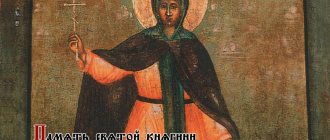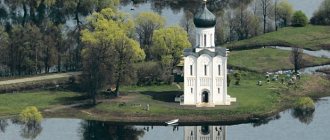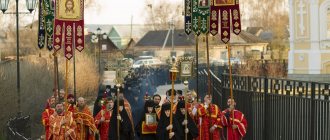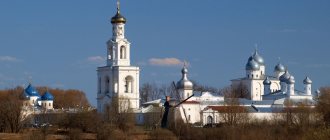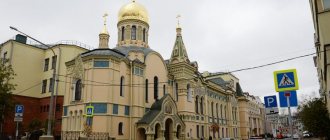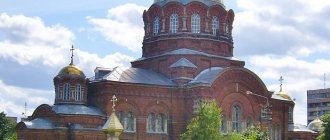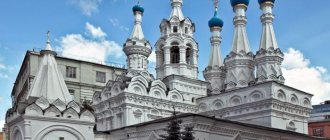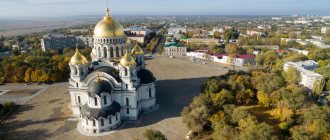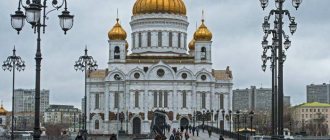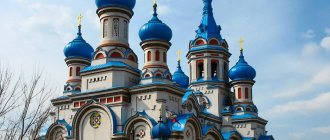Saint Anna Kashinskaya is revered by Orthodox people as the patroness of family and children, a helper in ending all family troubles. A hundred years ago, in 1909, a temple in the name of Anna Kashinskaya was consecrated in St. Petersburg on Sampsonievsky Prospekt. The church is still active today.
Princess Anna
Today the city of Kashin is a regional center in the Tver region. And in the 14th century, on the banks of the Kashinka River there was a small estate of Prince Constantine. Nun Anna moved here to join her son. Her other son, Vaoilius, built a monastery here for his mother. Anna Kashinskaya was born around 1278. She was the daughter of the Rostov prince Dmitry Borisovich. She was raised in the Orthodox faith. She was surrounded by people who were kind, peaceful, and pious. In 1294, Anna was married to the Tver prince Mikhail Yaroslavovich. The time was difficult then - the Mongol-Tatar yoke. Russian princes from time to time visited the Golden Horde to receive a label for the principality. The khan also called them for other reasons. One day, the ruler of the Horde, Uzbek, ordered Mikhail Tverskoy to appear to him. The point was that Yaroslavich was slandered. To add insult to injury, the Russian princes also did not get along with each other and tried to trip each other up. True, the Tver prince was no different in this. He was generally alien to any intrigues, so with a clear conscience he went to Uzbek Khan, although he was dissuaded. But if we didn’t go, we would have ruined the entire Tver land. And in the Golden Horde the prince suffered martyrdom. Subsequently, Mikhail Tverskoy was canonized. Then Princess Anna lost her two sons in the Horde. After that, she took monastic vows and moved to Kashin. Residents of the city revered her already during her lifetime for her wisdom, piety, and generous charity to the poor. Anna Kashinskaya died in 1368. She was buried in the Cathedral of the Assumption Monastery.
- Description
- Trips here (1)
Description of the Church of St. Anna Kashinskaya - metochion of the Vvedeno-Oyatsky convent
The Church of St. Anna Kashinskaya in St. Petersburg was the first to be built and consecrated in honor of this saint. And today it remains the only temple in Russia entirely dedicated to Anna Kashinskaya. The history of the temple is closely connected with the city of Kashin, Tver region.
In 1894, on the Vyborg side of St. Petersburg, on a plot donated by hereditary honorary citizen F.P. Kruchinin, the courtyard of the Kashinsky Sretensky Monastery was opened. At first it was planned to build a chapel, which was consecrated on April 3, 1894 in honor of St. Nicholas the Wonderworker in memory of the rescue of Tsarevich Nikolai Alexandrovich during an assassination attempt in the Japanese city of Otsu. “Such a mass of people gathered for the consecration that traffic along the avenue, not only on horseback, but also on foot, was stopped.”
In the middle of the site in 1901, a three-story stone outbuilding was built according to the design of S. Andreev. Various stone services were built in the depths of the courtyard. But the sisters of the monastery were constantly preoccupied with the idea of building a temple.
Its project was commissioned from the young diocesan architect Andrei Petrovich Aplaksin (1879-1931). The temple was supposed to be consecrated in the name of the Savior, the Image Not Made by Hands, with two chapels: St. Nicholas the Wonderworker and St. Alexis of Moscow. The architect was faced with the difficult task of fitting a temple designed for 1,500 worshipers into a narrow plot stretching from west to east within an existing building. Aplaksin coped with this task brilliantly. The temple, along with the nearby Sampsonievsky Cathedral, occupied a dominant position in the surrounding buildings. This was the master’s first project in the non-traditional “neo-Russian” style for St. Petersburg.
A committee for the construction of the temple was created, and a preliminary design was included in the appeal asking for help in the construction of the temple. Using the funds raised by the committee in September 1907, the ceremonial foundation stone of the temple took place and construction began.
The construction of the temple was completely completed in 1909, that is, precisely when the Tver land was tremblingly celebrating the restoration of the veneration of the holy blessed princess Anna Kashinskaya, therefore, of course, it was decided to consecrate the main throne in her honor. The consecration ceremony took place on December 18 (31), 1909.
The revolutionary events of 1917 suspended the work of the diocesan architect, and the Anna Kashinskaya Church did not remain untouched. It lasted as a monastery courtyard until 1925, but even then the community of the parish church was made up of nuns. But in 1932, all the nuns were arrested, 15 of them were sent into exile in Kazakhstan, 3 to concentration camps. At the same time, the church was closed, and the priest and his family were also repressed.
Only in 1994, the dilapidated temple was returned to the Church for the establishment of a monastery courtyard, but now the Vvedeno-Oyatsky convent of the St. Petersburg diocese.
Currently, the Church of St. Anna Kashinskaya was restored and decorated with a unique iconostasis.
Source: https://www.oyatsky.ru/podvore/istoriya-i-sovremennost.html
Pilgrimage trips to the Church of St. Anna of Kashin - the metochion of the Vvedeno-Oyatsky convent
- A trip from St. Petersburg to the Church of St. Anna Kashinskaya - at the courtyard of the Vvedeno-Oyatsky Convent
Vision of Sexton Gerasim
Over time, Anna's burial place was forgotten. But the residents of Kashin felt that someone was protecting them from harm. During the Time of Troubles, the Poles and Lithuanians ravaged more than one Russian city. They repeatedly approached Kashin. And each time they retreated without causing harm to the city. And in 1611, the seriously ill sexton of the Assumption Cathedral, Gerasim, had a vision in a dream: a nun appeared and called herself Anna. She promised Gerasim healing, but at the same time she reproached the residents of the city for forgetting about her: “The people regard my coffin as nothing, you consider it ordinary and despise me. People put their hats on my coffin and sit on it. And how long will you trample me underfoot? Don’t you know that I pray to God for you and save you from many evils and misfortunes?” Few people believed the sexton’s dream, but Gerasim really recovered. And after some time, the floor of the temple rotted, the floorboards collapsed, and a stone coffin opened up. After this, the people poured into the cathedral and began to pray fervently. Numerous healings took place near the princess’s tomb. Before Anna's canonization, 41 miracles were recorded. After the incident, Mikhail Tverskoy’s wife was canonized.
Vvedeno-Oyatsky Convent
The Church of St. Anna Kashinskaya in St. Petersburg was the first to be built and consecrated in honor of this saint. And today it remains the only temple in Russia entirely dedicated to Anna Kashinskaya. The history of the temple is closely connected with the city of Kashin, Tver region.
In 1894, on the Vyborg side of St. Petersburg, on a plot donated by hereditary honorary citizen F.P. Kruchinin, the courtyard of the Kashinsky Sretensky Monastery was opened. At first it was planned to build a chapel, which was consecrated on April 3, 1894 in honor of St. Nicholas the Wonderworker in memory of the rescue of Tsarevich Nikolai Alexandrovich during an assassination attempt in the Japanese city of Otsu. “Such a mass of people gathered for the consecration that traffic along the avenue, not only on horseback, but also on foot, was stopped.” In the middle of the site in 1901, a three-story stone outbuilding was built according to the design of S. Andreev. Various stone services were built in the depths of the courtyard. But the sisters of the monastery were constantly preoccupied with the idea of building a temple. Its project was commissioned from the young diocesan architect Andrei Petrovich Aplaksin (1879-1931). The temple was supposed to be consecrated in the name of the Savior, the Image Not Made by Hands, with two chapels: St. Nicholas the Wonderworker and St. Alexis of Moscow. The architect was faced with the difficult task of fitting a temple designed for 1,500 worshipers into a narrow plot stretching from west to east within an existing building. Aplaksin coped with this task brilliantly. The temple, along with the nearby Sampsonievsky Cathedral, occupied a dominant position in the surrounding buildings. This was the first
masters in a non-traditional “neo-Russian” style for St. Petersburg. A committee for the construction of the temple was created, and a preliminary design was included in the appeal asking for help in the construction of the temple. Using the funds raised by the committee in September 1907, the ceremonial foundation stone of the temple took place and construction began. The construction of the temple was
, that is, precisely when the Tver land was tremblingly celebrating the restoration of the veneration of the holy blessed princess Anna Kashinskaya, therefore, of course, it was decided to consecrate the main Throne in her honor. The consecration ceremony took place on December 18 (31), 1909. The revolutionary events of 1917 suspended the work of the diocesan architect, and the temple of Anna Kashinskaya did not remain untouched. It lasted as a monastery courtyard until 1925, but even then the community of the parish church was made up of nuns. But in 1932, all the nuns were arrested, 15 of them were sent into exile in Kazakhstan, 3 to concentration camps. At the same time, the church was closed, and the priest and his family were also repressed. Only in 1994
returned to the Church for the establishment of a monastery courtyard under it, but now the Vvedeno-Oyatsky convent of the St. Petersburg diocese.
Currently
and decorated with unique work
.
Unique case
In 1678, Saint Anne fell into disgrace. By decision of the cathedral, her veneration was canceled. They were forbidden to dedicate prayers to her, but only to sing dirges. It was also forbidden to paint icons of the disgraced Saint. The reason for this decision was the following case: when opening the relics (they were incorruptible), they discovered that Anna Kashinskaya’s right hand was folded with two fingers for the sign of the cross. And at that time there was a struggle with the schism, they constantly argued about how to be baptized correctly - with two or three fingers. Saint Anna Kashinskaya became the banner of the Old Believers. Therefore, church ministers of the new wave went to excommunicate the princess from the list of Saints. This is the only case in the history of the Russian Orthodox Church. Anna Kashinskaya remained in disgrace near the church until 1909. However, ordinary people continued to venerate the Saint. In difficult times, without fear of publicity, the residents of Kashin went to her relics. There is even a known case that occurred in 1864. Merchant Ermolai Fleshcheev suffered from epilepsy. One day, another seizure occurred: Ermolai fell, hitting a cabinet, from which an ancient icon of the blessed princess Anna fell out. The image covered the patient's face. The seizure stopped immediately, and Fleshcheev had no more seizures at all! The people of Kashin constantly worked to restore the veneration of St. Anna. But only in 1909 the request of the residents of Kashin was granted. The princess was again canonized. And in St. Petersburg a church was erected in her honor.
Anna Kashinskaya Church in St. Petersburg - history and architecture
The Church of Anna Kashinskaya in St. Petersburg is one of the oldest city Orthodox churches: construction of the courtyard of the Kashinsky Sretensky Monastery began in 1907.
The church building is located in the Vyborg district on Bolshoi Sampsonievsky Avenue, 53.
The Church of Anna Kashinskaya was built according to the design of the diocesan architect A.P. Aplaksina. The project included a two-story church with an adjacent chapel and residential buildings in the courtyard. The performance style is neo-Russian.
Photo: Yandex
Photo: Yandex Aplaksin A.P.
The history of the church is unique. Originally, this place was occupied by the chapel of St. Nicholas the Wonderworker, built in 1894 to commemorate the miraculous salvation of the future Emperor Nicholas II in Japan.
In November 1907, the new chapel of St. Nicholas the Wonderworker was consecrated. In February 1908, the miraculous chapel of the Savior was consecrated in the lower church. The main chapel was consecrated in the name of Anna Kashinskaya in 1909.
After 1917, the courtyard was closed, the church became a parish church, but the nuns continued to live in the courtyard extension. They were arrested in February 1932 during the mass arrests of monks in Leningrad and its environs, and then exiled.
Photo: Yandex Church of St. Anna Kashinskaya 1909-1917 Complex of the Kashinsky Sretensky Convent. Church of the village Anna Kashinskaya.
Photo: Yandex Church of St. Anna Kashinskaya 1984
Soon, in 1933, the church was also closed, and some icons were moved to Sampsonievsky Cathedral. In 1934, the church was prepared for an explosion, which, however, did not happen. In 1939, the church housed art workshops.
After two years of neglect, in 1994, the entire courtyard complex was transferred to the Vvedeno-Oyatsky convent. The church lay in ruins: crumbling bricks, demolished domes, broken glass, a flooded basement, failed engineering systems.
Restoration work has been ongoing since 1995. In 1996-1997, the domes were rebuilt, heating was installed, water was pumped out from the basement, and the windows were glazed. In 2009, the temple celebrated its centenary. The restoration of the temple has already been completely completed, a chandelier has been purchased.
Photo: Yandex Church of St. Anna Kashinskaya 1999
Photo: Yandex
Architecture
The temple has four pillars for construction, divided by pillars into three naves, on the sides of which there are two-story galleries. In 1911, chapels dedicated to St. Nicholas the Wonderworker and St. Alexei Metropolitan of Moscow were consecrated on the upper floors of these galleries.
The architecture of the temple shows the features of Pskov-Novgorod architecture of the 15th century. The walls are plastered in dark red (after restoration the color became straw yellow). The church is crowned with a helmet-shaped dome with a pointed dome on a low drum.
The dominant architectural composition is a slender three-level bell tower topped with an onion dome. In plan, the main part of the bell tower has a square shape, the third step is round. Majolica icons and frescoes are included in the decorative design of the facades. The portico was built in the Russian style, topped with an onion dome with an imperial crown.
Currently, the temple is the metochion of the Vvedeno-Oyatsky Monastery of the Tikhvin Diocese of the Russian Orthodox Church and belongs to the cultural heritage of the peoples of the Russian Federation of regional significance.
Photo: Yandex 2015
Photo: Yandex
Follow us on social networks:
Enjoy content from our new column “OLD PETER”
Temple of Anna Kashinskaya
The Vyborg side of St. Petersburg has always been predominantly a factory district. At the beginning of the 19th century, there were clearly not enough Orthodox churches here, so people flocked to the Pashkovite sect. The teaching of the sect was Protestant in nature, that is, icons, candles, church sacraments, and clergy were not recognized. The sect was organized after the English preacher Lord Redstock visited the city. His views were echoed by retired Colonel Pashkov. The St. Petersburg clergy was very concerned about the influence of the Pashkovites on the local flock. Therefore, they decided to build an Orthodox church on Sampsonievsky Avenue. This plot of land was donated to the Kashin Convent by an honorary citizen of St. Petersburg, a native of Kashin, Philip Pavlovich Kruchinin. And on the Vyborg side they began to build a church and a courtyard of the Kashinsky monastery. The ceremonial consecration of the temple took place in December 1909. It is worth noting that the last Russian Tsar did a lot to ensure that the veneration of Anna Kashinskaya was restored.
Story
This parish is the only one in our country entirely dedicated to this saint of God. Initially, there was a small chapel of St. Nicholas, erected in 1894 in gratitude for the miraculous salvation of the future sovereign Nikolai Alexandrovich during his trip to Japan. The plot of land on which it was located belonged to the Kashinsky Sretensky Monastery.
In 1901, according to the drawings of town planner Semyon Andreev, a three-story stone outbuilding was built here and utility rooms were installed. And a few years later, the construction of the temple began according to the design of the young architect Andrei Petrovich Aplaksin (1879-1931). The task was a responsible one: a church for one and a half thousand parishioners had to be placed on a small site already built up with various buildings.
Temple of the Holy Prince Anna Kashinskaya, St. Petersburg
But the architect did a great job. When constructing the temple, he turned to the ancient Pskov and Novgorod traditions, improving them and establishing a new architectural direction - the “neo-Russian” style. The Main Throne was initially planned to be dedicated to the Image of the Savior Not Made by Hands, but by the time construction work was completed, this decision was changed. In those days, Russia reverently celebrated the second glorification of the blessed princess Anna Kashinskaya, and, therefore, the main altar was also consecrated in her honor. This happened on December 18 (31), 1909.
After the Revolution, the courtyard existed, without being subjected to atheistic persecution, until 1932. And then, one night, all the nuns were taken into custody.
Interesting fact
The night from February 17 to 18, 1932 was popularly nicknamed “Good Friday of Russian monasticism.” That night, in the North-West of the state, several hundred inhabitants of the Makarievskaya Hermitage, the Alexander Nevsky Lavra, Ioannovsky, Staraya Ladoga, Vokhonovsky, Pyatogorsky, and Novodevichyevsky Resurrection Monasteries were taken into custody. The best representatives of the clergy were arrested, who were later canonized as martyrs and saints: St. Arefa (Mitrenin), prmch. Lev (Egorov), Venerable Patricky (Petrov), prmts. Maria (Lelyanova). On the same night, the sisters of the Kashin monastery were also arrested, most of whom were sent into exile.
At first, the workshop of the sculptor Tomsky was located in the premises of the courtyard, and then they were given over to the sculpture workshop of the decorative and applied arts plant.
In 1994, the dilapidated buildings, practically beyond restoration, were returned to the church. Now they belong to the courtyard of the Vvedeno-Oyatsky convent of the St. Petersburg diocese.
The rector of the temple, Priest Mikhail (Nevinsky), says:
“Every week at the courtyard we serve an akathist to St. Anna Kashinskaya. As soon as they began to pray to Saint Anna, everything gradually began to settle down by itself, and the desire to work only increased. We have increased the number of services. The people reached out. Many come to Anna Kashinskaya and talk about miracles created through prayers to her. It is a pity that we have not yet begun to record these testimonies, although, on the other hand, saints and shrines do not need advertising. People go to church for consolation, receive it, and stay.”
